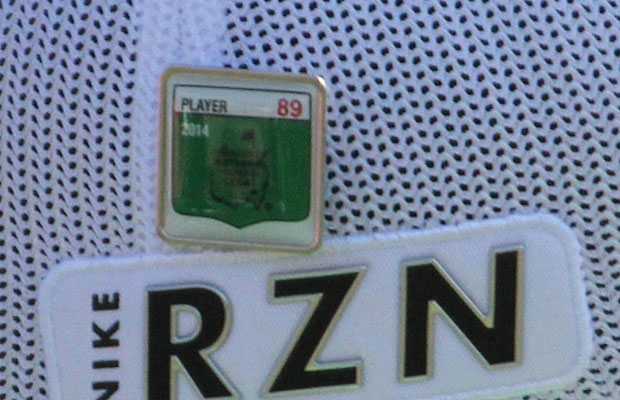Opinion & Analysis
“A tradition unlike any other”

By Dennis de Jesus Jr.
GolfWRX Contributor
What is it about the Masters that makes the casual fan think of it as the greatest golf tournament in the world? I spent most of my Good Friday watching the Masters coverage, and though the timing of the CBS telecast didn’t show much of the second round clubhouse leaders, I was still glued to the TV like I was watching some sort of “once in a lifetime” event. And chances are I wasn’t alone.
Social media and the news reports all suggest that this could be the most watched golf tournament in the 2012 season. With a carousel at the top of the world golf rankings and a healthy Tiger Woods in the field, I can see why this may be the case. But what is it about this particular tournament that manages to get fans of the sport (both casual and hardcore) glued to the TV, unlike any other tournament on the schedule? Why are workplaces around the world able to pull off a “Masters Office Pool”, getting people to spend money and try to pick golfers that they haven’t even heard of for their weekend roster?
I’m sure there are many reasons, but I’m going to try and summarize what I believe are the three key reasons why the Masters is the biggest tournament of the year:
1. The Masters is the only major tournament that is held on the same course year in and year out.
For 76 years, Augusta National has hosted the Masters tournament and out of the four majors, this is the only one that has consistently been played on the same course. It may not seem like a big deal, but I truly believe that if you were to ask any professional athlete, there seems to be an inherent nostalgia when you are playing the big game in the very same location as some of your childhood legends. Ben Hogan walked this very course, Jack Nicklaus teed off over there many times and Arnold Palmer sank a putt on that green right over there to win the 1964 Masters.
It’s hard to ignore the history that has been written on this course and it’s because of the stories about golf shots that happened at Amen Corner, the reason behind the Eisenhower tree or the drive up Magnolia Lane that give personality to a golf course that is seemingly a bigger star than any player competing on it.
2. The media promotes the heck out of this tournament.
“A tradition unlike any other.” What the heck does that even mean? It’s a four round golf tournament where the winner gets a nice handsome check and some sort of tangible prize to take home. It happens once a year and is played on a golf course littered with spectators yelling “in the hole” split seconds after a tee shot from a par 3. Sounds like any other golf tournament to me.
But Jim Nantz saying that every year in the weeks leading up to the event does not get tiresome. It actually makes sense. It’s a self sufficient tournament with its own rules, its own way of doing business and makes no apologies if it bothers you, your dog or if you are a woman. Behind the scenes, Augusta National is filled with controversy with its archaic traditional values and stubborn nose-in-the-air policies. But every spring, it hosts the can’t miss tournament of the year. Fans comes from everywhere to smell the azaleas and well manicured greens to watch the only golf tournament that matters, because that’s what we are conditioned to believe.
It’s supposed to be a magical place where if you are one of the lucky few to see it, you are envied by your weekend golf buddies who couldn’t afford it or didn’t win the lottery tickets to simply have an opportunity to buy tickets. The Golf Channel is on pre-round and post-round coverage while major news outlets will even show highlights of the 3-foot eagle that so and so made on the par 5 15th. Media coverage for this tournament is so overwhelming that even in hockey-crazed Canada, it’s not unusual for each round to headline the sports landscape despite the dramatic playoff chases happening in the NHL.
There is even special edition merchandise like golf shoes that are in Masters green or yellow colorways. Nike released a special Masters edition of their latest Method Concept putter to celebrate this years tournament. Click here to see the story. If it’s not the media, it is now the manufacturers who are getting on the propaganda bandwagon, bombarding us with reminders that this tournament is a big deal and is in fact unlike any other.
3. Tour players have a love affair with this course.
The interviews of the tour players all seem to suggest that Augusta is a challenging and difficult course, but also fair. From all the homage and respect of its undulating greens and hanging branches, it’s as if the 7,435-yard par-72 Augusta National is the most perfectly designed course in the entire world. Now, I haven’t played a lot of courses around the world nor am I good enough to understand what a pro would consider as difficult, but on the Tiger Woods video game on the PS3, the course is just “alright”. (Before you all jump on me for such blasphemy, I’m just kidding. I’m not going to judge the actual course based on my score of 61 from the back tees of Augusta armed with my game controller).
It’s no big secret that a lot of tour players, especially the successful and experienced ones (like Tiger, Fred or Phil) gear up their entire schedule for this tournament. When asked, “What is the one tournament that you would like to win, more than any other one?” the answer from many a tour player, past winners or not, is simply “Augusta”. And the same answer would result if you asked any golf fan, “What is the one golf course you would like to play on, regardless of cost?”
The history and legend at Augusta is one that continues to grow because we get to see it every year. And with each annual edition, there are a host of stories that journalists and beat writers can sink their teeth into and make into a future 30 for 30 program. For me personally, it signals springtime and is the first indicator that my golf season is about to start. Though I may never get to step foot on the course, I buy into the idea that this is a special place, a Mecca of golf if you will. So every year, I spend some of my money to play in the office pool, sit my butt on the couch for a weekend to enjoy the greenery in high definition and enjoy Jim Nantz’s calming voice as he calls the action from the 18th green. It only happens once a year so it is definitely worthy of being a tradition – and on the other 51 weeks, I have my PS3 to tide me over.
You can follow Dennis on Twitter @jugojr.
Opinion & Analysis
The 2 primary challenges golf equipment companies face

As the editor-in-chief of this website and an observer of the GolfWRX forums and other online golf equipment discourse for over a decade, I’m pretty well attuned to the grunts and grumbles of a significant portion of the golf equipment purchasing spectrum. And before you accuse me of lording above all in some digital ivory tower, I’d like to offer that I worked at golf courses (public and private) for years prior to picking up my pen, so I’m well-versed in the non-degenerate golf equipment consumers out there. I touched (green)grass (retail)!
Complaints about the ills of and related to the OEMs usually follow some version of: Product cycles are too short for real innovation, tour equipment isn’t the same as retail (which is largely not true, by the way), too much is invested in marketing and not enough in R&D, top staffer X hasn’t even put the new driver in play, so it’s obviously not superior to the previous generation, prices are too high, and on and on.
Without digging into the merits of any of these claims, which I believe are mostly red herrings, I’d like to bring into view of our rangefinder what I believe to be the two primary difficulties golf equipment companies face.
One: As Terry Koehler, back when he was the CEO of Ben Hogan, told me at the time of the Ft Worth irons launch, if you can’t regularly hit the golf ball in a coin-sized area in the middle of the face, there’s not a ton that iron technology can do for you. Now, this is less true now with respect to irons than when he said it, and is less and less true by degrees as the clubs get larger (utilities, fairways, hybrids, drivers), but there remains a great deal of golf equipment truth in that statement. Think about it — which is to say, in TL;DR fashion, get lessons from a qualified instructor who will teach you about the fundamentals of repeatable impact and how the golf swing works, not just offer band-aid fixes. If you can’t repeatably deliver the golf club to the golf ball in something resembling the manner it was designed for, how can you expect to be getting the most out of the club — put another way, the maximum value from your investment?
Similarly, game improvement equipment can only improve your game if you game it. In other words, get fit for the clubs you ought to be playing rather than filling the bag with the ones you wish you could hit or used to be able to hit. Of course, don’t do this if you don’t care about performance and just want to hit a forged blade while playing off an 18 handicap. That’s absolutely fine. There were plenty of members in clubs back in the day playing Hogan Apex or Mizuno MP-32 irons who had no business doing so from a ballstriking standpoint, but they enjoyed their look, feel, and complementary qualities to their Gatsby hats and cashmere sweaters. Do what brings you a measure of joy in this maddening game.
Now, the second issue. This is not a plea for non-conforming equipment; rather, it is a statement of fact. USGA/R&A limits on every facet of golf equipment are detrimental to golf equipment manufacturers. Sure, you know this, but do you think about it as it applies to almost every element of equipment? A 500cc driver would be inherently more forgiving than a 460cc, as one with a COR measurement in excess of 0.83. 50-inch shafts. Box grooves. And on and on.
Would fewer regulations be objectively bad for the game? Would this erode its soul? Fortunately, that’s beside the point of this exercise, which is merely to point out the facts. The fact, in this case, is that equipment restrictions and regulations are the slaughterbench of an abundance of innovation in the golf equipment space. Is this for the best? Well, now I’ve asked the question twice and might as well give a partial response, I guess my answer to that would be, “It depends on what type of golf you’re playing and who you’re playing it with.”
For my part, I don’t mind embarrassing myself with vintage blades and persimmons chasing after the quasi-spiritual elevation of a well-struck shot, but that’s just me. Plenty of folks don’t give a damn if their grooves are conforming. Plenty of folks think the folks in Liberty Corner ought to add a prison to the museum for such offences. And those are just a few of the considerations for the amateur game — which doesn’t get inside the gallery ropes of the pro game…
Different strokes in the game of golf, in my humble opinion.
Anyway, I believe equipment company engineers are genuinely trying to build better equipment year over year. The marketing departments are trying to find ways to make this equipment appeal to the broadest segment of the golf market possible. All of this against (1) the backdrop of — at least for now — firm product cycles. And golfers who, with their ~15 average handicap (men), for the most part, are not striping the golf ball like Tiger in his prime and seem to have less and less time year over year to practice and improve. (2) Regulations that massively restrict what they’re able to do…
That’s the landscape as I see it and the real headwinds for golf equipment companies. No doubt, there’s more I haven’t considered, but I think the previous is a better — and better faith — point of departure when formulating any serious commentary on the golf equipment world than some of the more cynical and conspiratorial takes I hear.
Agree? Disagree? Think I’m worthy of an Adam Hadwin-esque security guard tackle? Let me know in the comments.
@golfoncbs The infamous Adam Hadwin tackle ? #golf #fyp #canada #pgatour #adamhadwin ? Ghibli-style nostalgic waltz – MaSssuguMusic
Podcasts
Fore Love of Golf: Introducing a new club concept

Episode #16 brings us Cliff McKinney. Cliff is the founder of Old Charlie Golf Club, a new club, and concept, to be built in the Florida panhandle. The model is quite interesting and aims to make great, private golf more affordable. We hope you enjoy the show!
Opinion & Analysis
On Scottie Scheffler wondering ‘What’s the point of winning?’

Last week, I came across a reel from BBC Sport on Instagram featuring Scottie Scheffler speaking to the media ahead of The Open at Royal Portrush. In it, he shared that he often wonders what the point is of wanting to win tournaments so badly — especially when he knows, deep down, that it doesn’t lead to a truly fulfilling life.
View this post on Instagram
“Is it great to be able to win tournaments and to accomplish the things I have in the game of golf? Yeah, it brings tears to my eyes just to think about it because I’ve literally worked my entire life to be good at this sport,” Scheffler said. “To have that kind of sense of accomplishment, I think, is a pretty cool feeling. To get to live out your dreams is very special, but at the end of the day, I’m not out here to inspire the next generation of golfers. I’m not out here to inspire someone to be the best player in the world, because what’s the point?”
Ironically — or perhaps perfectly — he went on to win the claret jug.
That question — what’s the point of winning? — cuts straight to the heart of the human journey.
As someone who’s spent over two decades in the trenches of professional golf, and in deep study of the mental, emotional, and spiritual dimensions of the game, I see Scottie’s inner conflict as a sign of soul evolution in motion.
I came to golf late. I wasn’t a junior standout or college All-American. At 27, I left a steady corporate job to see if I could be on the PGA Tour starting as a 14-handicap, average-length hitter. Over the years, my journey has been defined less by trophies and more by the relentless effort to navigate the deeply inequitable and gated system of professional golf — an effort that ultimately turned inward and helped me evolve as both a golfer and a person.
One perspective that helped me make sense of this inner dissonance around competition and our culture’s tendency to overvalue winning is the idea of soul evolution.
The University of Virginia’s Division of Perceptual Studies has done extensive research on reincarnation, and Netflix’s Surviving Death (Episode 6) explores the topic, too. Whether you take it literally or metaphorically, the idea that we’re on a long arc of growth — from beginner to sage elder — offers a profound perspective.
If you accept the premise literally, then terms like “young soul” and “old soul” start to hold meaning. However, even if we set the word “soul” aside, it’s easy to see that different levels of life experience produce different worldviews.
Newer souls — or people in earlier stages of their development — may be curious and kind but still lack discernment or depth. There is a naivety, and they don’t yet question as deeply, tending to see things in black and white, partly because certainty feels safer than confronting the unknown.
As we gain more experience, we begin to experiment. We test limits. We chase extreme external goals — sometimes at the expense of health, relationships, or inner peace — still operating from hunger, ambition, and the fragility of the ego.
It’s a necessary stage, but often a turbulent and unfulfilling one.
David Duval fell off the map after reaching World No. 1. Bubba Watson had his own “Is this it?” moment with his caddie, Ted Scott, after winning the Masters.
In Aaron Rodgers: Enigma, reflecting on his 2011 Super Bowl win, Rodgers said:
“Now I’ve accomplished the only thing that I really, really wanted to do in my life. Now what? I was like, ‘Did I aim at the wrong thing? Did I spend too much time thinking about stuff that ultimately doesn’t give you true happiness?’”
Jim Carrey once said, “I think everybody should get rich and famous and do everything they ever dreamed of so they can see that it’s not the answer.”
Eventually, though, something shifts.
We begin to see in shades of gray. Winning, dominating, accumulating—these pursuits lose their shine. The rewards feel more fleeting. Living in a constant state of fight-or-flight makes us feel alive, yes, but not happy and joyful.
Compassion begins to replace ambition. Love, presence, and gratitude become more fulfilling than status, profits, or trophies. We crave balance over burnout. Collaboration over competition. Meaning over metrics.
Interestingly, if we zoom out, we can apply this same model to nations and cultures. Countries, like people, have a collective “soul stage” made up of the individuals within them.
Take the United States, for example. I’d place it as a mid-level soul: highly competitive and deeply driven, but still learning emotional maturity. Still uncomfortable with nuance. Still believing that more is always better. Despite its global wins, the U.S. currently ranks just 23rd in happiness (as of 2025). You might liken it to a gifted teenager—bold, eager, and ambitious, but angsty and still figuring out how to live well and in balance. As much as a parent wants to protect their child, sometimes the child has to make their own mistakes to truly grow.
So when Scottie Scheffler wonders what the point of winning is, I don’t see someone losing strength.
I see someone evolving.
He’s beginning to look beyond the leaderboard. Beyond metrics of success that carry a lower vibration. And yet, in a poetic twist, Scheffler did go on to win The Open. But that only reinforces the point: even at the pinnacle, the question remains. And if more of us in the golf and sports world — and in U.S. culture at large — started asking similar questions, we might discover that the more meaningful trophy isn’t about accumulating or beating others at all costs.
It’s about awakening and evolving to something more than winning could ever promise.

















Pingback: “A tradition unlike any other” « wgtgolf
Lauren Conrad
Apr 7, 2012 at 6:56 pm
The feeling is definitely mutual. Ultra-Super-Mega Fine Course.
Pingback: “A tradition unlike any other” | Augusta Blog